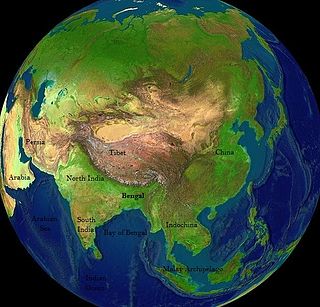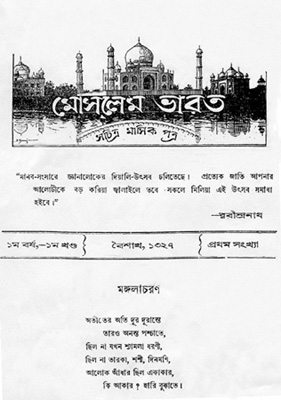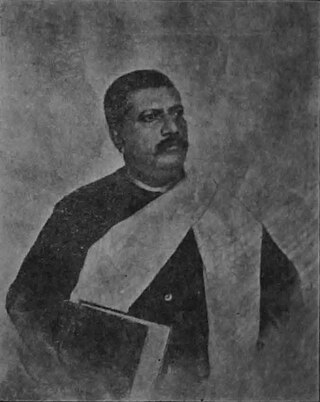Related Research Articles

Bengal is a historical geographical, ethnolinguistic and cultural term referring to the eastern part of the Indian subcontinent at the apex of the Bay of Bengal. The region of Bengal proper is divided between modern-day Bangladesh and the Indian state of West Bengal. The administrative jurisdiction of Bengal historically extended beyond the territory of Bengal proper. Bengal ceased to be a single unit after the partition of India in 1947.

The first Partition of Bengal (1905) was a territorial reorganization of the Bengal Presidency implemented by the authorities of the British Raj. The reorganization separated the largely Muslim eastern areas from the largely Hindu western areas. Announced on 20 July 1905 by Lord Curzon, the then Viceroy of India, and implemented on 16 October 1905, it was undone a mere six years later. The nationalists saw the partition as a challenge to Indian nationalism and that it was a deliberate attempt to divide the Bengal Presidency on religious grounds, with a Muslim majority in the east and a Hindu majority in the west. The Hindus of West Bengal complained that the division would make them a minority in a province that would incorporate the province of Bihar and Orissa. Hindus were outraged at what they saw as a "divide and rule" policy, even though Curzon stressed it would produce administrative efficiency. The partition animated the Muslims to form their own national organization along communal lines. To appease Bengali sentiment, Bengal was reunited by Lord Hardinge in 1911, in response to the Swadeshi movement's riots in protest against the policy.

Bengali literature denotes the body of writings in the Bengali language and which covers Old Bengali, Middle- Bengali and Modern Bengali with the changes through the passage of time and dynastic patronization or non-patronization. Bengali has developed over the course of roughly 1,300 years. If the emergence of the Bengali literature supposes to date back to roughly 650 AD, the development of Bengali literature claims to have 1,600 years of old. The earliest extant work in Bengali literature is the Charyapada, a collection of Buddhist mystic songs in Old Bengali dating back to the 10th and 11th centuries. The timeline of Bengali literature is divided into three periods: ancient (650–1200), medieval (1200–1800) and modern. Medieval Bengali literature consists of various poetic genres, including Hindu religious scriptures, Islamic epics, Vaishnava texts, translations of Arabic, Persian and Sanskrit texts, and secular texts by Muslim poets. Novels were introduced in the mid-19th century. Nobel laureate Rabindranath Tagore is the best known figure of Bengali literature to the world. Kazi Nazrul Islam, notable for his activism and anti-British literature, was described as the Rebel Poet and is now recognised as the National poet of Bangladesh.
The Star was an English-language evening newspaper in Pakistan that ceased publication in 2005.
Sheikh Abdur Rahim was a Bengali writer and journalist.

Puthukkody Kottuthody Sankaran Kutty Nair, better known as Kutty, was an Indian political cartoonist.

The Nawab of Dhaka, originally spelt in English Nawab of Dacca, was the title of the head of largest Muslim zamindar in British Bengal and Assam, based in present-day Dhaka, Bangladesh. The title of nawab, similar to the British peerage, was conferred upon the head of the family by Queen Victoria as a recognition of the first Nawab's loyalty and contribution to the social welfare activities.
Abul Kalam Shamsuddin was a journalist, politician and littérateur. He was born at Trishal of Mymensingh.

The culture of Bengal defines the cultural heritage of the Bengali people native to eastern regions of the Indian subcontinent, mainly what is today Bangladesh and the Indian states of West Bengal and Tripura, where the Bengali language is the official and primary language. Bengal has a recorded history of 1,400 years. The Bengali people are its dominant ethnolinguistic group. The region has been a historical melting point, blending indigenous traditions with cosmopolitan influences from pan-Indian subcontinental empires. Bengal was considered to be the richest part of Islamic medieval India and during the era of the Bengal Sultanate it was described to be a major trading nation in the world, while during Mughal times, having triggered the proto-industrialization, its economy was worth 12% of global GDP. Dhaka became the capital of Mughal Bengal and the commercial capital (1610-1757) of Mughal Empire. Dhaka became one of the richest and greatest cities in the world and the prosperity of Dhaka reached its peak during this time. The current (2021) estimated GDP (Nominal) of Dhaka is $150 Billion to $200 Billion. As a part of the Bengal Presidency, Bengal also hosted the region's most advanced political and cultural centers during British rule. Kolkata became the capital (1758-1911) and the financial capital (1758-1947) of the British India. Kolkata grew rapidly in the 19th century to become one of the richest and greatest cities in the world and the second most important city of the British Empire after London. The current (2021) estimated GDP (Nominal) of Kolkata is $50 Billion to $100 Billion. Historically Feudalism has been widespread in the entire eastern Indian region. The feudal system flourished to a large extent under the British administration, which served as a means to exploit the Indian peasants by the British colonizers. This created a class of rich landlords in Bengal and a large population of poor peasants. It is noteworthy that a major portion of the Bengali intellectual community during the British era emerged from this wealthy class of landlords, as primarily they belonged to well educated families and got the economic opportunities to receive English education, often from abroad. The lower social classes remained in abject poverty and illiteracy. Thus, although the contribution of the Bengali intellectual community has been immense towards literature, science, politics and the Indian freedom movement, but still as it flourished under an exploitative imperial government, it mostly constituted of individuals belonging to the wealthy landlord families.
Sudhakar was a Bengali weekly magazine established by Reazuddin Ahmad Mashadi and Sheikh Abdur Rahim. It began publication on 8 November 1889 from Kolkata.
Ponabalia Massacre was the mass murder of 20 Bengali Muslims in Ponabalia by members of the Indian Imperial Police on orders of the district magistrate on 7 March 1927.
Prabhavathi Devi Saraswathi was an Indian Bengali writer and novelist.
Reazuddin Ahmad Mashadi was a Bengali Muslim writer and philosopher.
Muhammad Reazuddin Ahmad (1861–1933) was a Bengali Muslim writer, journalist, and thinker.
Mearajuddin Ahmad was a 19th-century Bengali academic, writer, and Islamic scholar.

Al Hakam is an English-language, Islamic newspaper, published weekly by the Ahmadiyya Muslim Jama'at.

The Muslim Bharat was a historic literary journal that published from Kolkata in the early 20th century. It published works by notable Bengali authors and poets; such as Abanindranath Tagore, Kalidas Roy, Kaikobad, Qazi Imdadul Haq, Kazi Abdul Wadud, Kumud Ranjan Mullick, Mohitlal Majumdar, Mohammad Barkatullah, Satyendranath Dutta, Sheikh Fazlul Karim, and Syed Emdad Ali.

Rai Bahadur Dewan Kaliprosanna Ghosh, CIE Vidyasagar was a Bengali journalist, writer and scholar.
Bengal Gazetti was a historic Bengali weekly newspaper published in India in 1816 or 1818 and is one of the oldest publications in India. It is believed to the first Bengali Language newspaper. The journal was edited by Ganga Kishore Bhattacharya, a former employee of Serampore Mission Press. The newspaper was short lived due to paper being an expensive commodity.
Meerza Delawar Hosaen Ahmed was the first Muslim graduate from the University of Kolkata. He is believed to the first Muslim graduate in India. He served as a civil servant and was awarded the title of Khan Bahadur. He was known for his progressive outlook and support for intellectual and cultural awakening of Bengali Muslims.
References
- ↑ Āhamada, Oẏākila (1988). The Index of the Muhammadan Observer and the Moslem Chronicle (a Weekly Newspaper, Estab. 1868): Politics, Literature, and Society, 1895-1905. Dhaka University Library.
- ↑ Rees, John David (1908). The Real India. Methuen & Co. p. 190.
- ↑ The Contemporary Review. A. Strahan. 1897. p. 286.
- ↑ Imam, Abu. "Moslem Chronicle, The". en.banglapedia.org. Banglapedia. Retrieved 16 August 2020.
- ↑ "Hosaen, Delawar". en.banglapedia.org. Banglapedia. Retrieved 16 August 2020.
- ↑ The Hindustan Review ... 1910. p. 411.